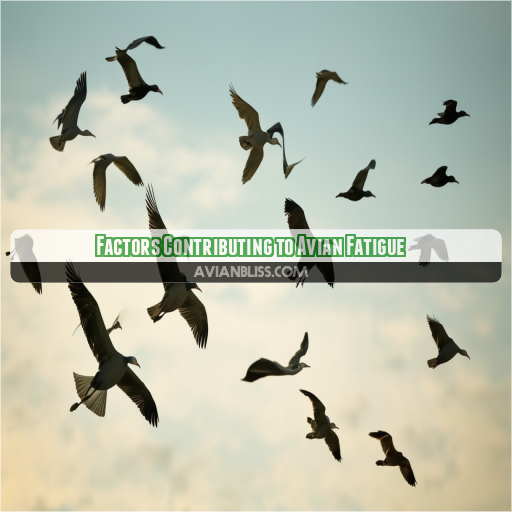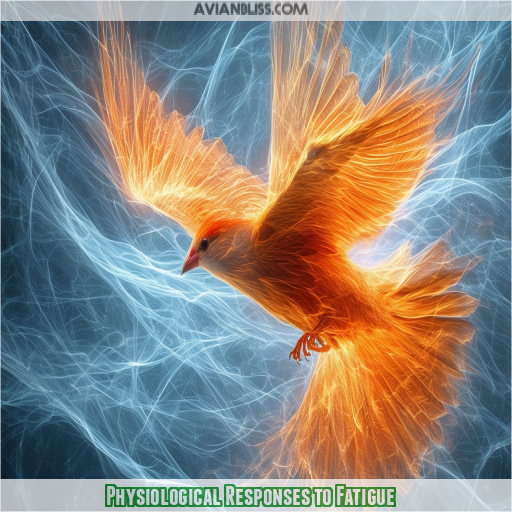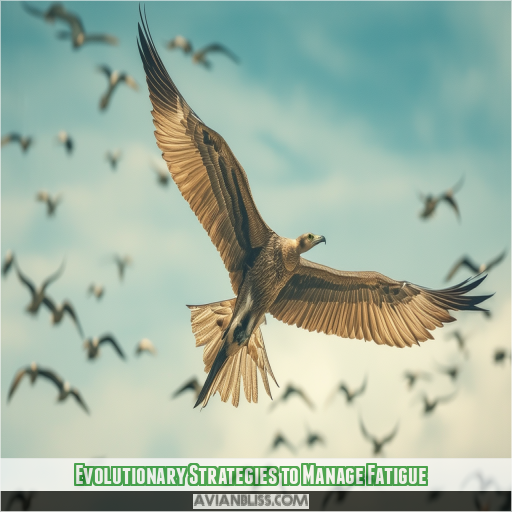This site is supported by our readers. We may earn a commission, at no cost to you, if you purchase through links.
 Yes, birds absolutely get tired of flying. Their remarkable feats of endurance come at a cost – energy depletion, muscle fatigue, and cardiovascular strain take a toll.
Yes, birds absolutely get tired of flying. Their remarkable feats of endurance come at a cost – energy depletion, muscle fatigue, and cardiovascular strain take a toll.
Environmental factors like wind and pollution exacerbate this avian fatigue during migrations.
But don’t worry, they’ve evolved clever strategies to manage it, from aerodynamic wing designs to intermittent flapping patterns.
So while birds are marvels of evolutionary adaptation, even they need to catch their breath sometimes.
Intrigued? Let’s soar deeper into the physiological demands and ingenious coping mechanisms nature has gifted our feathered friends.
Table Of Contents
Key Takeaways
- Birds may be the kings of the sky, but even they need to catch their breath sometimes – their remarkable feats of flight come at a cost of energy depletion, muscle fatigue, and cardiovascular strain.
- Just like us humans, our feathered friends have evolved clever strategies to manage fatigue, from aerodynamic wing designs that slice through the air like a hot knife through butter, to intermittent flapping patterns that let them conserve energy and take a breather.
- Environmental factors like wind, pollution, and inclement weather can really ruffle a bird’s feathers and exacerbate fatigue during migrations, making their journey a true test of endurance.
- To ensure our avian pals can keep soaring high, we need to prioritize conservation efforts that mitigate stressors like habitat loss, climate change, and human disturbances – after all, a world without the melodic songs of birds would be a real crip in the arm.
Do Birds Get Tired of Flying?
Yes, birds do get tired of flying. Even though their bodies are adapted for efficient flight, prolonged or strenuous flying can lead to fatigue in birds due to the metabolic demands and physical exertion involved.
Factors Contributing to Avian Fatigue
Birds expend significant metabolic energy during flight, especially for long-distance migrations and traversing challenging environmental conditions like strong winds or inclement weather. These factors contribute to avian fatigue, requiring birds to employ various physiological and behavioral strategies to manage their energy reserves and rest adequately.
Metabolic Demands of Flight
Flight is an energy-intensive process that severely taxes a bird’s metabolism. Their aerobic capacity is pushed to the limit, requiring:
- Efficient energy metabolism to fuel muscle contractions
- Enhanced respiratory adaptations for oxygen delivery
- Effective thermoregulation to dissipate heat
Maintaining this high energy expenditure is a monumental physiological challenge that birds must overcome.
Environmental Factors
Environmental factors like air pollution, disease transmission, wind conditions, and temperature extremes can greatly increase avian fatigue. You’ll find birds struggle to fly in:
- Polluted areas with poor air quality
- Regions with airborne pathogens
- Strong headwinds and gusts
- Extreme heat or cold snaps
These environmental stressors tax a bird’s physiology, draining energy reserves faster and intensifying fatigue.
Migration and Long-Distance Travel
For migratory birds, long-distance travel is an arduous undertaking. They face:
- Environmental impact from traversing across diverse habitats.
- Navigation challenges due to sleep deprivation.
- Foraging strategies to sustain energy during flight.
Social interactions are limited as they prioritize reaching their destination, pushing their limits to conquer the journey.
Physiological Responses to Fatigue
Birds experience muscle fatigue during flight as a result of the continuous contractions required to power their wing movements. Additionally, the cardiovascular system experiences strain from sustaining the elevated metabolic rate and oxygen demands of prolonged aerial activity.
Muscle Fatigue
Prolonged flight strains avian muscles, leading to fatigue. As wings flap relentlessly, muscle fibers experience:
- Decreased efficiency in energy conversion
- Buildup of lactic acid and other metabolites
- Reduced force production and power output
- Impaired mechanics due to muscle damage
Proper rest and recovery are essential for restoring muscle function and preventing injury in birds. Muscle fatigue is a significant factor impacting their ability to sustain flight.
Cardiovascular Strain
You’ll also experience cardiovascular strain as avian fatigue sets in. Your heart must work harder, increasing:
- Blood pressure regulation
- Oxygen extraction efficiency
- Cardiac hypertrophy for sustained flight
Vasoconstriction reduces blood flow to non-essential muscles, maximizing aerodynamic efficiency despite mounting exhaustion.
Neurological Responses
During prolonged flights, birds experience neurological fatigue due to sustained brain activity. This manifests as:
- Decreased alertness and reaction times
- Disrupted circadian rhythms and sleep patterns
- Impaired decision-making and navigation abilities
- Altered sensory perception and spatial awareness
Proper rest and sleep are essential for neurological recovery and peak performance.
Behavioral Adaptations to Fatigue
Birds employ various behavioral strategies to cope with fatigue.
They rest and sleep to conserve energy.
They strategically forage and feed to replenish fuel reserves.
They engage in social interactions that may facilitate recovery or share the burden of challenging activities.
These adaptive behaviors are essential for maintaining the overall health and fitness of birds, particularly during periods of high energy demand like migration or breeding.
Rest and Sleep
Optimizing rest and sleep is essential for birds to combat fatigue. 1) They enter torpor, lowering metabolism to conserve energy. 2) Roosting sites provide secure sanctuaries for quality sleep. 3) Circadian rhythms regulate sleep cycles aligned with daylight. Strategic nesting behavior guarantees sufficient rest periods for recuperation.
Foraging and Feeding
While resting, birds must also efficiently forage and feed. They employ strategies like:
- Targeting high-energy foods like seeds and insects
- Optimizing feeding techniques for minimal effort
- Adjusting food preferences based on nutrient needs
- Enhancing digestive efficiency to maximize energy intake
These adaptations help birds conserve energy while meeting their caloric demands during periods of fatigue.
Social Interactions
Moving on to social interactions, you’ll find birds often adjust their communication patterns when fatigued. By relying on group cohesion, they can:
- Employ cooperative foraging strategies to conserve energy
- Engage in social bonding rituals to strengthen group dynamics
- Modify mating strategies to prioritize energy conservation
Staying socially connected helps birds manage fatigue through collective efforts.
Evolutionary Strategies to Manage Fatigue
Birds have evolved remarkable adaptations in wing design, such as high aspect ratio wings and efficient feather arrangements, to optimize aerodynamics and reduce energy expenditure during flight.
Additionally, they exhibit variations in flight behavior, like intermittent flapping and gliding. They also have physiological mechanisms like increased fat storage and efficient oxygen delivery, enabling them to manage fatigue effectively over long distances.
Adaptations in Wing Design
You’ll find birds have evolved remarkable wing designs to combat fatigue. 1) Slotted feathers reduce drag, 2) Elliptical wings offer high lift, 3) Skeletal lightweighting minimizes energy costs, and 4) Flexible wings morph for ideal aerodynamics in any situation. These adaptations grant superior muscle endurance and energy efficiency during flight.
Variations in Flight Behavior
In addition to wing design adaptations, birds have evolved strategic flight patterns to combat fatigue. These include:
- Soaring on thermals to minimize flapping
- Intermittent flapping and gliding to reduce oxygen consumption
- V-formations for improved aerodynamics and shared wind resistance
- Varying wing flexibility to optimize muscle endurance
- Adjusting altitude for favorable air currents and conditions
Physiological Mechanisms
In addition to altering flight behaviors, birds have evolved intricate physiological mechanisms to combat fatigue. These include: 1) Efficient oxygen transport systems, 2) Metabolic adaptations for sustained high-energy demands, and 3) Thermoregulatory mechanisms to dissipate heat generated during flight. By mastering these internal processes, birds gain an aerodynamic advantage, extending the boundaries of endurance and accessing new domains of freedom in the skies.
Implications for Bird Conservation
Habitat fragmentation and disturbance pose significant threats to bird populations, as they disrupt migration routes, fragment nesting and foraging habitats, and increase energy expenditure. Additionally, climate change and environmental stressors exacerbate the challenges birds face, as rising temperatures, altered precipitation patterns, and extreme weather events can impact food availability, water sources, and overall habitat suitability.
Habitat Fragmentation and Disturbance
Habitat fragmentation and disturbance severely impact avian fatigue. Birds struggle to find suitable resting spots due to:
- Habitat loss from urbanization and deforestation
- Habitat degradation from pollution and human activities
- Noise pollution disrupting sleep and roosting
- Light pollution disrupting circadian rhythms
- Urbanization creating inhospitable environments
Climate Change and Environmental Stressors
Climate change presents a formidable challenge for avian fatigue management, with:
- Habitat loss disrupting migration routes and depleting food sources
- Pollution fouling air and water, exacerbating physiological stress
- Disease vectors expanding due to warming temperatures
- Increased competition for dwindling resources among species
These environmental stressors compound the energy demands of flight, amplifying fatigue’s toll on bird populations.
Conservation Strategies
With avian fatigue impacting bird populations, conservation strategies must prioritize mitigating stressors. Consider these approaches:
- Habitat restoration to create safe havens.
- Reducing human disturbances near nesting sites.
- Monitoring population dynamics for early interventions.
- Promoting sustainable practices that minimize environmental degradation.
Addressing avian fatigue through proactive measures ensures long-term survival and thriving of our feathered friends.
Frequently Asked Questions (FAQs)
Do birds take breaks during long-distance migrations?
Yes, birds take breaks during long-distance migrations. They rest at stopover sites to refuel with food and water, regaining their energy before continuing their journey, ensuring they maintain their strength and endurance.
How do weather conditions affect bird fatigue?
Like a bird battling fierce winds, harsh weather drains a flyer’s stamina. Strong gusts and precipitation increase energy expenditure, hastening muscle fatigue during migration flights.
Can birds sleep while flying and soaring?
Yes, birds can sleep while flying and soaring like the swimming and flying birds. They take short naps, entering a state of unihemispheric slow-wave sleep where one hemisphere stays awake for navigation.
Do different species vary in fatigue tolerance?
You bet birds fatigue at wildly different rates! Energetic hummingbirds tire quickly, flapping frantically; majestic eagles soar for hours, scarcely flapping those wide wings. Study species’ physiology to grasp their soaring prowess.
What role does diet play in fatigue?
You’re right to contemplate diet – proper nutrition fuels a bird’s energy reserves for long-distance flights. High-calorie foods like seeds and insects provide the stamina needed to soar without fatigue.
Conclusion
Just as a bird’s wings spread majestically during flight, unraveling the intriguing realities of avian fatigue illuminates nature’s marvels.
From ingenious physiological adaptations to behavioral strategies, birds’ remarkable endurance in overcoming exhaustion reminds us that even they, masters of the sky, must grapple with the inevitable toll of fatigue.
"Do birds get tired of flying?" is a resounding proof of life’s delicate balance between soaring and rest.








